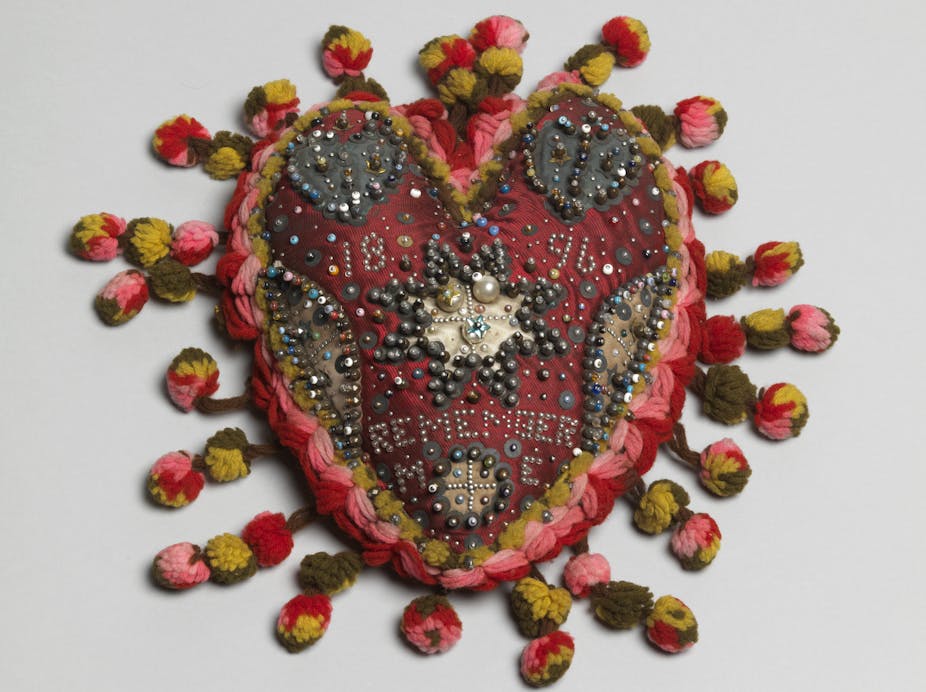Folk is fashionable. Its latest manifestation at Tate Britain is only the most recent of stirrings – it been on the up for a number of years. Perhaps most obviously is the resurgence of folk music, which has been growing in popularity for a while. Inevitably tied to this has been the accompanying interest in folk festivals, as a younger generation of musical artists push the boundaries of what the folk sound can be.
But what folk means in terms of the visual arts is a little more elusive, and so its renaissance is less obvious.
Tate Britain’s latest exhibition contains objects that are rarely embraced within a traditional art or design historical canon. So there are Toby jugs, poignant art made by wounded soldiers, as well as the three-dimensional shop hoardings of a less corporate retail age.
Such a plethora of objects denies classification: they range from large to small, the everyday to the extraordinary, the useful to the decorative. Some were anonymously made, some not. They also defy the usual time frames of artistic periods or revolutions. The large thatched sculpture made by master craftsman Jesse Maycock, calls on the materials, skills and imagery of generations before, at a time when British art was looking to new medias and abstraction.

But these objects are not completely timeless or distant. They have regularly haunted the edges of fine art and design practice. Folk artist Alfred Wallis, for example, was drawn into a lineage of Modernist art in St. Ives: his bold ships’ figureheads were part of the visual education given to Peter Blake and his contemporaries.
The idea of folk
So the idea of what folk even is remains elusive. And the appearance of such a show suggests that it is again important for us to think about these evocative objects, that they somehow pluck and tug at us in a particular way again.
The Tate Britain exhibition is particularly related to an interest in a previous folk revival that occurred during the 1930s and 40s in Britain. This was when designers saw the authentic vibrancy of all that was “folk” as being under threat from a growing trend to standardise during a time of complex international political upheaval.
This idea of folk or the “popular arts” is an umbrella term referring to everything from the crowded aesthetic of faded Victorian pomp, to narrow boat decorations, corn dollies, pub interiors and peddler dolls. And though of interest to male and female designers alike, the popular arts were notably championed by people like Enid Marx and Barbara Jones who translated it into their practice.
In contemporary design particularly, this folk revival has a tendency to “whimsify” in the spirit of only some 1940s design. We see this trend for nostalgia in the Cath Kidston style, forties austerity chic, the bearded young men sporting short back and sides, and brogues. What we are seeing in this folk renaissance is perhaps not simply an interest in folk itself, but an affinity with the spirit of immanent loss that drove this love of things folk post-war.
Why now? Perhaps it is no coincidence that to ask this question chimes with similar regarding Eurosceptism, the renewed interest in the royals and in conservatism. Our nostalgic interest in folk still tussles with ideas of the socialist versus the conservative, the industrialised versus the rural, the contemporary versus the traditional.
Folk of the future
But there is another strand of interest in folk that is not quite so stuck in the past, and perhaps provides some hope for folk in the future that is not simply nostalgic. This begins with a generation of artists that began their careers in the late 1980s and early ‘90s.

These artists use the language of folk in order to confront today’s culture in a more oblique fashion. Work such as Jeremy Deller and Alan Kane’s Folk Archive (2005), a documentation of vernacular decoration and objects made into an online exhibition by the British Council, asks important questions about who exactly the “folk” are. This particular piece asks what makes up British tradition and ethnicity, and demands we think about them in more fluid ways. It claims as much authenticity for Pizza Hut as for Stonehenge, Notting Hill Carnival as traditional Morris dancing – making us question our engrained idea of the British “folk”.
What this strain of folk in the contemporary visual arts does then, is to work fluidly through definitions of folk that have previously been problematic – built on contrasts of the industrial and the rural, the artificial and natural, the now and the then. It is, I think, significant that music reverberates within this work: folk music maintains an ability to transform but also holds on to its recognisable folk identity.
The Tate show, along with our folk nostalgia, should be seen as the story behind this contemporary artistic practice. To avoid being stuck in the past, we should embrace the opportunity it gives us to talk about the vibrancy of our evolving national identity, while being safe in the knowledge that the folk always seem to know what they are doing.
British Folk Art is on at Tate Britain until August 31 2014.

